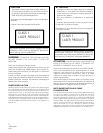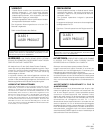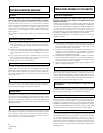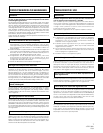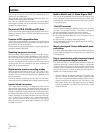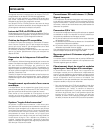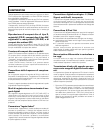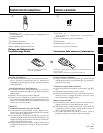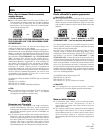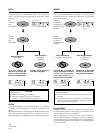
8
<PRE1269>
En/Fr
This unit can be used to record CD-R (CD recordable) discs or
CD-RW (CD rewritable) discs.
Once recorded, a CD-R disc cannot be erased. However, a re-
corded CD-RW disc can be erased later.
Both CD-R and CD-RW discs provide the high sound quality
and excellent durability that is the hall mark of ordinary prere-
corded CDs (compact discs).
Playback of CD-R, CD-RW and CD discs
This recorder can be used to play partially recorded CD-R or CD-
RW discs, finalized CD-R or CD-RW discs and ordinary prere-
corded CD discs.
Creation of CD-compatible discs
A CD-R disc can be played on any ordinary CD player just like
ordinary prerecorded CD discs provided it has been finalized
(by recording TOC) after recording.*
CD-RW discs can only be played back on a player specially de-
signed to handle CD-RW discs.
Sampling frequency converter
When recording a digital source using 32 kHz or 48 kHz sam-
pling frequency such as satellite broadcasting, DAT and DCC,
this unit automatically converts the sampling frequency into
44.1 kHz which is the sampling frequency used with the CD.
However, the digital monitoring signal which is output during
recording with this unit is based on the same sampling fre-
quency as the recorded source.
Digital-source synchro recording modes
When recording digital signals from a CD, DAT, MD or DCC,
the recording on this unit can be started and stopped in syn-
chronism with the starting and stopping of the playback of the
source component.
A mode for synchro recording of a single track from the above-
mentioned sources is available so that edited recording is easy.
Legato-linked conversion
The “Legato-linked conversion” is designed to make musical
performance more natural. The signal format limits the fre-
quency of the signals recorded on discs at 20 kHz. However, as
sounds of nature and musical components of instruments con-
tain frequencies above 20 kHz, it cannot be said that the discs
contain recordings of the signal waveforms as they were origi-
nally. To deal with this problem, the “Legato-linked conver-
sion” provides closer musical performance to the original
sound by assuming the original signals based on the signals
recorded on the disc.
FEATURES
En
Build-in Multi-Level ∆Σ (Delta-Sigma) DAC
The multi-level Digal-Analog Converter achieves superior reso-
lution compared to the conventional Delta-Sigma DAC, thus
producing high conversion accuracy even when jitter is present
in the system clock.
1-bit A/D converter
The A/D converter (analog-to-digital converter) of this unit uses
the latest 1-bit conversion system. This system provides the
following advantages compared to previous systems.
÷ Zero-cross distortion does not occur from the principle.
÷ Non-linear distortion does not occur throughout the fre-
quency band.
÷ High accuracy is possible without adjustment.
These advantages preserve the original quality of the music in-
cluding low-level signals.
Newly-developed 3-beam differential push-
pull pickup
The newly developed 3-beam pickup with differential push-pull
system stabilizes operations and reproduces rich medium and
low frequencies.
Direct construction with minimized signal
path and separated digital and audio
The direct construction reduces cross-interference between
signals by achieving a correct signal transfer. It reproduces
musical signals with high purity by thoroughly improving the
distortion, channel separation and level linearity values. These
improvements are not in terms of values at a single point but
applied over a wide frequency range.
* Before CD-Rs can be played on ordinary CD players, they
must be 'finalized' (a process that fixes the contents of the
disc so that no further recording is possible). While most CD
players should have no problems with CD-R discs, if the
laser pickup is dirty (from prolonged exposure to tobacco
smoke, for example), the player may not be able to read
some CD-R discs.




